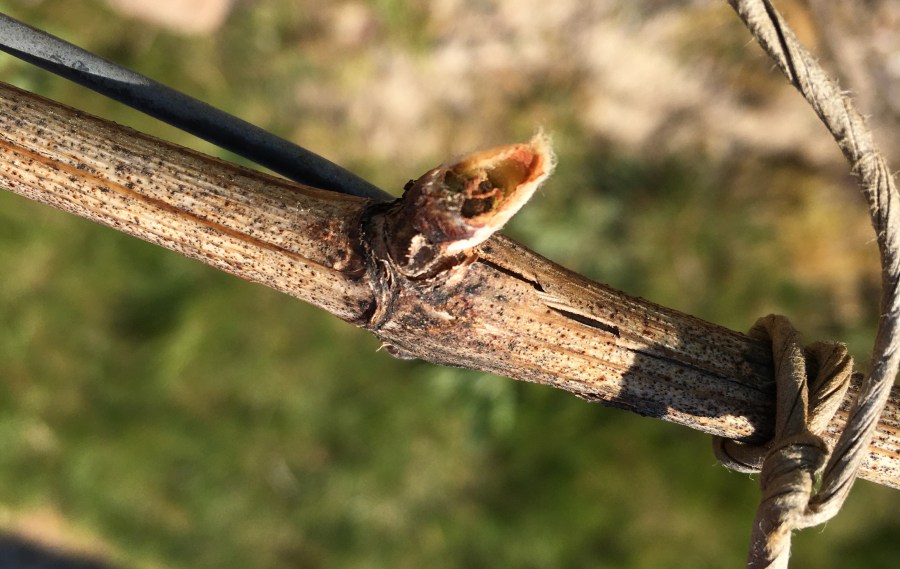Packed full of nutrients and carbohydrates, vine buds present an attractive proposition for pests, such as caterpillars and birds.
Losing primary and secondary buds has direct implications for yield, and creates gaps in the fruiting canopy, potentially complicating management decisions, as well as reducing productivity. Understanding the risks and how to mitigate them is key.
Cutworms
One pest that seems to be becoming more common is the cutworm, specifically the turnip moth larvae. This has been a threat to sugar beet for many years, but as the UK’s vine area increases, so it is being found more frequently – indeed, cutworm is an issue in vineyards elsewhere in the world.
Larvae overwinter in the surface layer of soil and pupate in the spring, usually coinciding with the point at which buds break dormancy and start to swell with green tips showing. Caterpillars move up vine trunks at night to feed on buds, with some – albeit unproven – reports suggesting they may travel to the end bud first, then work back along the cane, hollowing out both primary and secondary buds as they go. This is different to the damage in sugar beet, where cutworms chew through young stalks, causing plants to fall over.
Damage tends to be very localised and patchy in nature, and can be hard to distinguish from that caused by winter moth, or birds. Monitoring with pheromone traps during the moth’s main flying period of mid-April to July is useful to assess male moth activity and help predict overall risk, although does nothing for caterpillars themselves, for which control measures are fairly limited.
Contact insecticides are an option, though likely best applied at night given cutworms are nocturnal. Alternatively, light cultivation of the top 2cm-3cm around vines might disturb the surface enough to expose cutworms to natural predators, such as birds. Irrigation or heavy rainfall can also help indirectly, by washing larvae deeper into the soil, making it harder for them to reach the surface.
Bio-control in the form of beneficial nematodes is also an option, although experience with such products is fairly limited and is dependent on soil conditions. When applied to the soil, the nematodes enter and kill the cutworm larvae, then reproduce, increasing the nematode population in the surrounding area. Numbers decline once larvae have been killed.
Winter moths
Winter moths are another pest to be aware of, as they can be problematic in various crops, notably apples, pears, soft fruit, and vines.
Adult moths live through the colder winter months and females usually start laying eggs in February. Again, the larvae tend to hatch around the time that buds break dormancy, but unlike cutworms, winter moth caterpillars are diurnal, so feed during the day. They are bright green in colour, making them easy to identify – cutworms in contrast, are generally brown or grey.
Insecticides, such as spinosad, could be an option if pressure justifies their use, however the impact on any beneficial insects must always be considered. Good results can also be achieved with the biopesticide based on Bacillus thuringiensis, which is suitable for organic systems.
Birds
Wild birds can be something of a mixed blessing in vineyards. Large flocks of starlings, pigeons, or pheasants, for example, can pose a risk to both emerging buds, and ripe fruit later in the season, while other bird species offer important natural predation of many insect pests – tits, for instance, feed on vine Light Brown Apple Moth caterpillars and possibly cutworm. Bats too offer nighttime predation of some moths.
During early spring, pigeon grazing of buds is perhaps the biggest issue, and damage is usually easy to identify as pigeons tend to sit on the crown of the vine, hollowing out all buds around them. Finches in contrast, are smaller and lighter birds, that tend to perch on the ends of canes to eat buds.
With netting unlikely to be a viable option for most growers, placing bird scarers around the vineyard ahead of the main risk period is the best way to deter birds. But remember that late winter and early spring can still be quite stormy months, so scarers need to be robust enough, or you may need to repair or replace any that get damaged.




